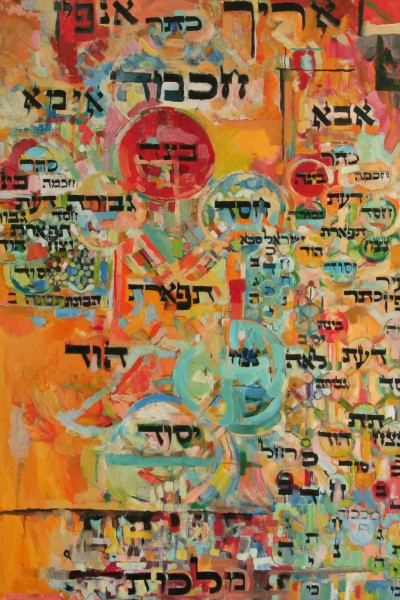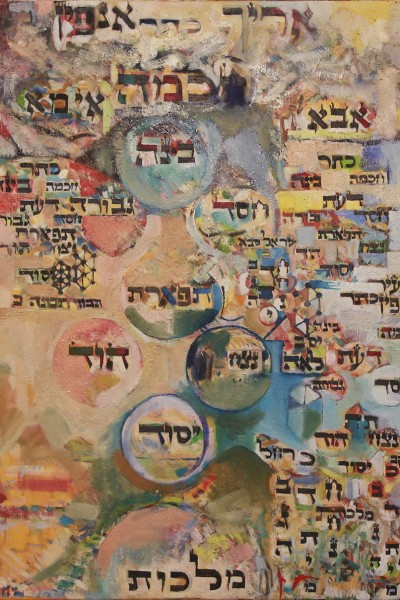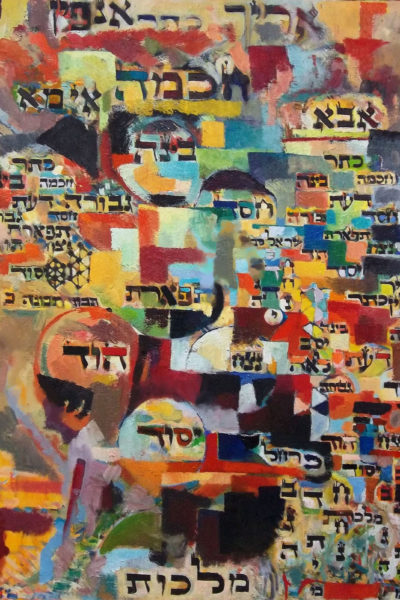I love many of your drawings (color ones). And I am in love with your paintings, the ones I have at home. You know that I have the feeling that they “change”? It’s interesting, it’s like they are not static but dynamic. As if I find something new or something comes out which makes them different. Does it make sense? Anyway, that makes them even more interesting!
What you say about the paintings changing. I am so glad that you are grasping this, for this is perhaps the most important aspect of them. I person who is not awake to spiritual reality may not understand and even reject this, but, for me, this is the main aspect of art–that it possess a living spirit, for truly nothing in existence is ‘inert’; rather everything is full of Elokut, Who fills all the worlds and surrounds all the worlds,…if an artist grasps that his work is connected to ‘The Life of all the Worlds’ then his become imbued with that spirit; the more he is connected to the Source of Life, the more his art connect the viewer also to Him. But the viewer must also have eyes and a spirit inclined to see…and the aspect of change is the nature of this world which is in constant change…and renewal…this is a timely subject as this is one of the deeper teachings of Rosh Hodesh Nissan and of Rosh Chodesh in general, Chodesh being the same language as Hadash–new, this is the matter of the renewal of the moon, which is malcuth and Yisrael…I am very sorry that I am writing in such brevity from lack of time; May Hashem give me the time and wisdom the prepare words that can reach into the well of this subject and bring forth pure water for thirsty souls.
1.There is the aspect of change in a picture from the side of the artist and from the side of the viewer. Even though the artist’s hand is no longer active in the picture, yet a person’s actions affect all of creation, whether directly or spiritually. This is seen most vividly in the matter of tsheuvah, as we are taught that tsheuvah has the power to transform reality. An action that occurred, how can it be changed? If someone, Heaven forbid, killed another, can he bring him back to life through regret? Nevertheless, we must understand, that tsheuvah does change the reality, erase the sin as if it never happened….therefore we see that in accordance with ones deeds the universe is changed, in it’s entirety, including the past. Thus an artist’s hand has in a sense not left the canvas, as the artist changes, so do his works, that is, even though the physical matter that is the paint has not changed yet the way that it appears to the world certainly is always in flux. To the extent the artist is actively involved in tsheuvah to that extent his work is ‘alive’ and improving with him, that is, revealing more of truth.
In the same way, as the viewer changes he sees in the same artwork new aspects.
-
there is the aspect of change which is the aspect of “there is no midrash without hidush”
-
there is the aspect of change in the creation of the work which is the parallel to the matter of making of Torah Tefilla. That is, one can actualize in his work the matter of tefilla which is the power of changing nature. The work can achieve the aspect of being an active tefilla which is in change.
5775
on the subject of what I have heard from others that my art changes for them, all the time—each time that they look they see it anew—
-
because it is connected above to That which doesn’t change, as it says: “I do not change” –(and how is it connected—by bitul—by my bitul of self-interest to the point of mesirat nefesh—I see (and paint) what is outside of me—then what is outside of them—between us all—HaKadosh Baruch Hu alone.[the truth is that there is nothing besides Him. Yet the is something which was created by Him, which must be understood as separate from Him, even though that this is a paradox. It can be understood that the essential matter that was created is bechira—the free choice of man. Man can choose not to see the truth—that there is nothing besides Him, normally this is manifest in a choice of only seeing oneself; complete self-interest. Yet if one chooses the path of life, to see and to live by the truth, so he fight against the darker side of his nature which is interested only in his self, until the point of bitul—annulment of self-interest, for the sake that Hashem’s presence should be manifest and magnified through his life.] So one who looks, he sees himself and he is changing [for the world reflects as a mirror the way we look at the world. Thus the majority of people who do not see the Creator in everything that happens to them, do not “see” Who it is Who does not change, see a world of multiplicity and change.] each time he looks he sees a new self. Because the [art]work [of mine] itself is above time and place—therefore it can show chadashot—for if it were in time and space it would appear the same always—like the chair appears (almost) the same always.
-
Also these are extensions of me and I change always—Baruch Hashem–they receive new light from me as I change. This is how we are—we implant light in each other when we meet. That light impression is implanted in another and changes in that other as the person who implanted changes. This is why our memories of a person change. Because that person is changing and directing all the impressions he has left in the past—because one’s past is connected to him. If he makes tsheuvah he can change the past entirely from bad to good.
-
Even in the time of sin, Heaven forbid –there is in the person the traits of tsheuvah—because the man is 2 yetzarim. He chose bad but the good was not nullified—just overlooked—so when he makes tsheuvah—his choosing good now is considered as if he chose good then. So if, for example, one is filmed speaking poorly about his friend—in the tone of his voice we hear that he degrades him. When he makes tseuvah—now e see in the same film that the tone is different. Because his conviction for good now prevents us from hearing bad from him—at any time [this is also the first inyan. Of being above time, for tsheuvah is above time. Thus the past is corrected, changed.] even if he said bad words—his being so strong now in this regret and and so embarrassed and in remorse and disgust of that part of himself that spoke those bad words—his true regret—Hashem answers and won’t allow that other part to be seen: the will of those who fear Him He fulfills He says: I am not that person. Hashem says: correcr: you are not—no one can see that person anymore.
-
there is a pashat: Behold, upon words of Torah it is brought: there is not midrash (study) without hidush (learning a new aspect) and: every time one examines them he finds in them new understanding. therefore pictures that have reached the level of “Torah”: thus is there reality.
featured image:
digital image: 16 “זכו שכינה בניהם”
slideshow images:
האילן הקודש: סדר השתלשלות העולמות והספירות
( נלקח מספר שערי רמח”ל)
HaEilan HaKadosh (The Holy Tree): The order of descension of the Worlds and the Sefirot.
(from The Gates of the Ramchal)
Oil on canvas
ציור שמן על קנבס
תשס”ח
80 cm. x 60 cm.




